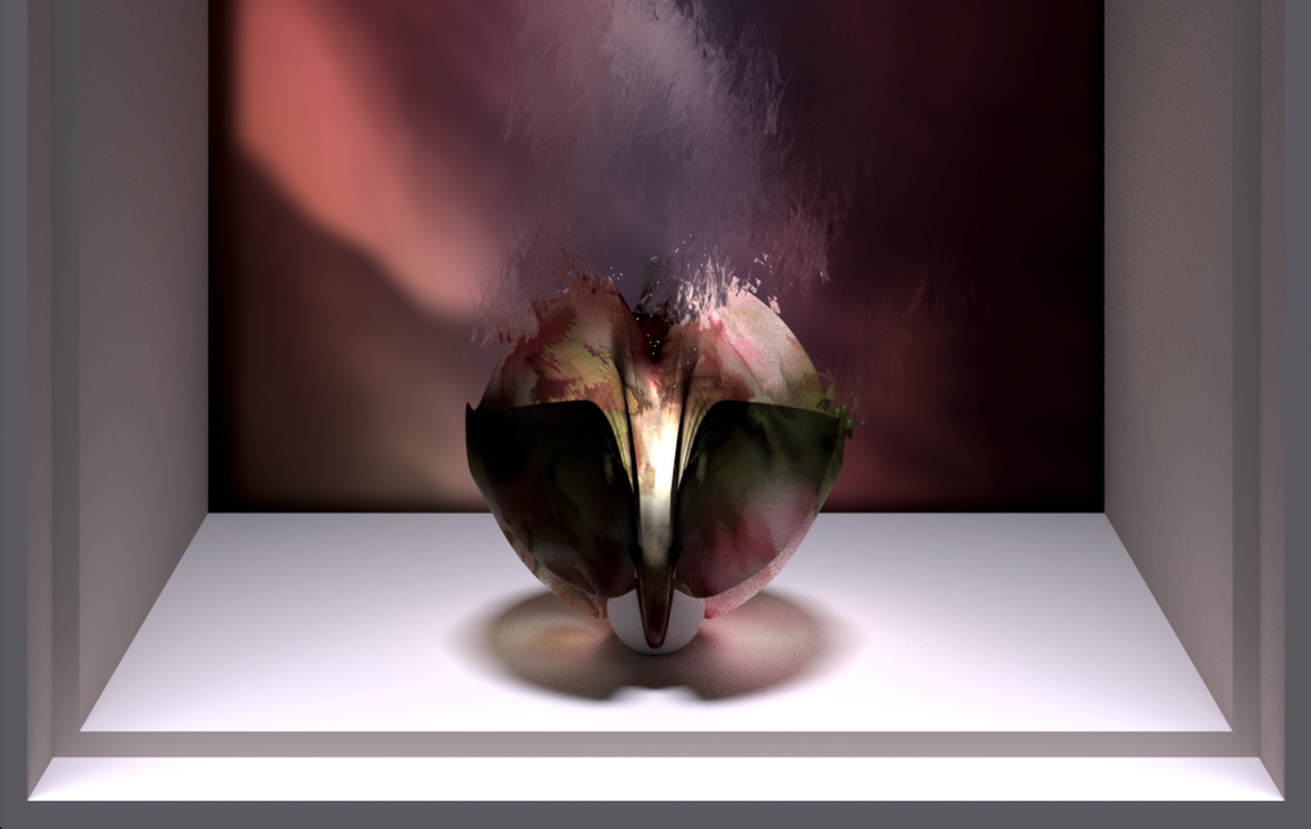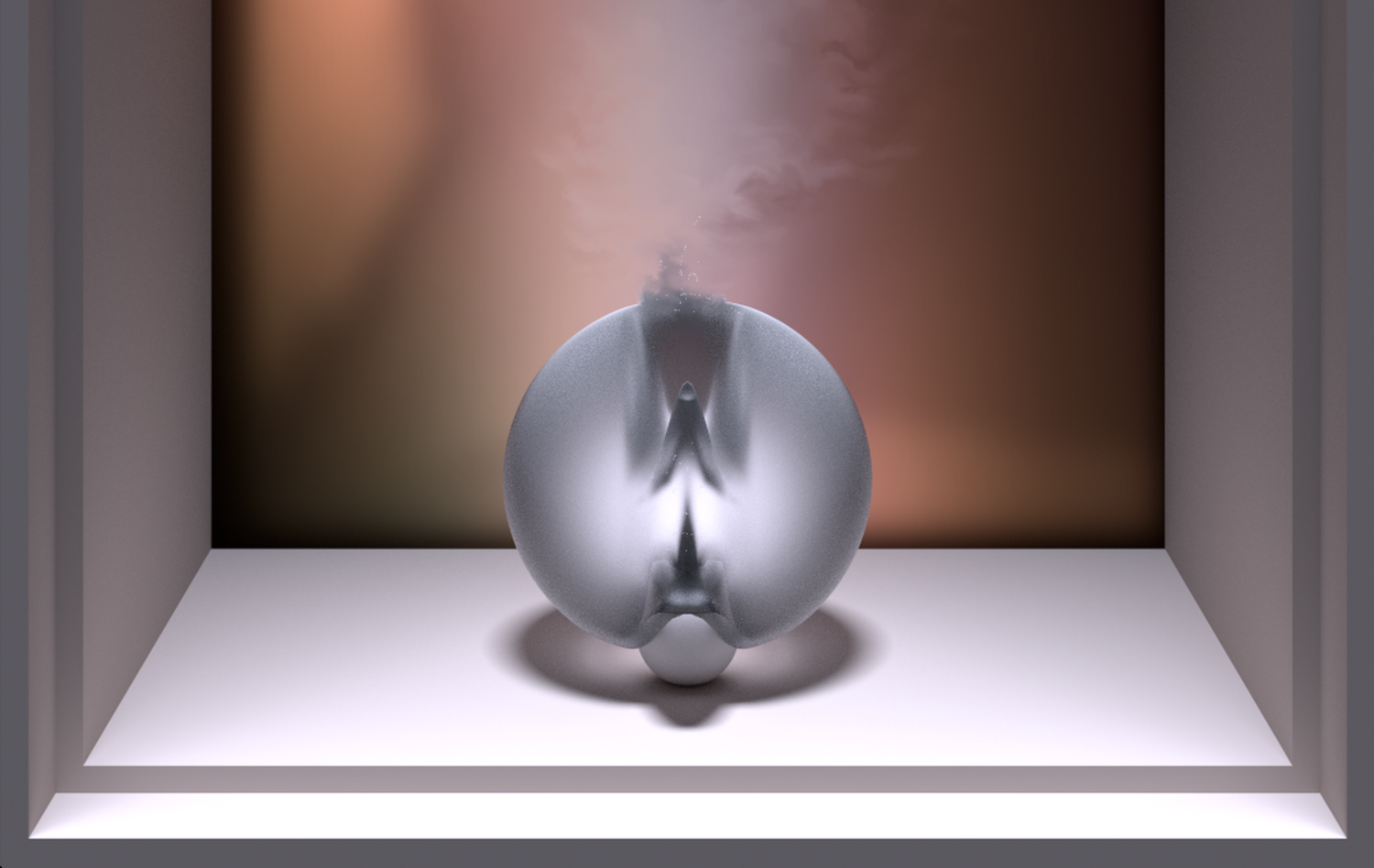VAPORS
A friction between the real and the simulated is manifested. With distorted, 3D modeled .gifs, artist Sara Ludy has created three prototypes of home products for her recent commission with NewHive, curated by Lindsay Howard. Her objects are seductive: small fantastical orbs that flicker and crack, becoming almost tangible through ambient sound and glittering graphics. Each emits a scented vapor that clouds her window displays, referring to a kind of immateriality that unexpectedly evokes nostalgia before vanishing—yet powerful enough in the present moment to displace time—as if a distant memory was happening once more. Mystery is inherent in these works, and much of Ludy’s practice centralizes the unknown spaces between what is instinctive and what can only be fantasized about. Scents pulled from the natural world, like peaches, passion fruit, and salt water, are alluded to, but rendered inaccessible, like so much else we encounter with our use of technology. The expectation of a literal sensory reaction is instead replaced by a more indirect response to an atmospheric illusion. The viewer experiences a disconnect of experience, the potency of such entirely reliant on each viewer’s ability to surrender authenticity for desire; their willingness to exist in those spaces Ludy elegantly presents.

Alexis Anais Avedisian: When did you start experimenting with domestic spaces, specifically the products made for these spaces?
Sara Ludy: I started working with interiors while living in Chicago. I was obsessed with science fiction and wrote short animated narratives. They featured robots and aliens, green-screened inside photoshopped collages.
It is my understanding from reading about your past work that you’ve done a lot of screen recording/investigation in Second Life. When you’re browsing and constructing these incorporeal worlds, do you find yourself projecting or creating your own version of utopia? I’m thinking about the description “blind indulgence” from your NewHive works; does this kind of control cause you to simulate your real-world presumptions?
Second Life is an island reflecting real-life isolation. Maybe if I were to own land, build, or participate in the Linden economy I would. On the other hand, Dream House, a 3D architecture I’ve been modeling for the last two years, has developed into a personal utopia. Since its debut as a modeled lucid dream space, it has evolved into a free zone that I can move around in and do whatever I want with. One day I will build a room, the next day I will replace it with a bridge. It’s a cost-efficient, eco-friendly dream house I can carry on my back and experience in countless ways.
Scent and memory are closely related. Are the vapors in your NewHive series related to personal memories? Are they meant to solicit memories?
Vapors are “home sense experiences,” providing a sense of place through each vapor. Personal memories were used to help shape the vibe of each vapor. For Peach Chateau, I recalled this room at my aunt’s house that was freezing cold and rarely used. It had glass tables and tropical rattan. A wall of windows faced southwest, letting warm light diffuse through the blinds. It smelled like vanilla peach. Passion Cove is related to my first impression of Miami. For Sea Basement, I subconsciously channeled Snorks.
I can’t assume Vapors will solicit memories from anyone as they are influenced by my subjective experiences. However, it’s possible, if my experiences are similar to the viewer’s or if they are viscerally feeling the vibe.
I’m interested in the elements of time displacement within these works. Our interactions with others in virtual spaces are often immediate and fleeting; yet at the same time, we are building and sharing an archive of our transactions. This archive can be seen as emotionally comforting, a place for revisiting the past, perhaps even nostalgic. Can you speak about this paradox?
The archive is built on moments you choose to make permanent. You decide what’s important and the rest you let go. Every day you’re looking at what other people project as important, which will influence what you project as important. We collectively build a palace of importance. The larger it becomes, the deeper you can go. The deeper you go, the more you experience time displacement. Time displacement is when you’re deep in the palace indulging in all things important.

Domestic shopping is still feminized in our culture. Advertisements for stores like TJ Maxx and HomeGoods typically feature shopping from a woman’s point of view. I’m referencing scented candles and air fresheners as a means to recreate faux-natural elements into the home, with “natural” scents meant to signify health and happiness. Additionally, we have Pinterest boards dedicated to aggregating romanticized imagery of homemaking, made for and circulated by women (90% of all pins are created and shared by women). These women are making their shopping preferences public, the advertisements becoming more a part of their “authentic” online selves. Were you thinking about these market relationships when titling your works Passion Cove and Peach Chateau?
Pinterest boards are shadow boxes reflecting our desires and emotional spaces. As a regular pinner, I’m surrounded by emotional advertising and individual preferences. The works I’ve been creating recently, like Vapors, are a way to reflect back the relationships we have with these images. Some pinners try to hoard all of Google with no personal preference. They lose a sense of who they are under the sheer density of their shadow boxes. They turn into a black hole. I follow one black hole right now.
Alexis Anais Avedisian is an artist, writer, and communications professional. She is a graduate student at NYU Steinhardt and a current Editorial Fellow for Rhizome at the New Museum. She works for the Office of Communications at MIT’s School of Architecture and Planning. Follow her on Twitter as @holyurl.